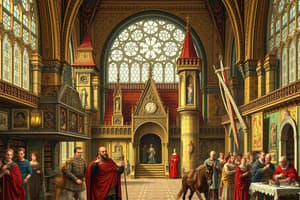Podcast
Questions and Answers
What is Caesaropapism?
What is Caesaropapism?
The idea of combining the power of secular government with religious power, making it superior to spiritual authority.
Who was Constantine and what were his main achievements?
Who was Constantine and what were his main achievements?
Reigned from 312-337, unified the empire, moved the capital to Constantinople, and made Christianity the official religion.
Who is Octavian, also known as Caesar Augustus?
Who is Octavian, also known as Caesar Augustus?
The founder of the Roman Empire and its first Emperor, ruling from 27 BC to 14 AD.
What does Pax Romana mean?
What does Pax Romana mean?
The Five Pillars of Islam include Shahadah, Salah, Sawm, Zahat, and ______.
The Five Pillars of Islam include Shahadah, Salah, Sawm, Zahat, and ______.
What were the Rightly Guided Caliphs responsible for?
What were the Rightly Guided Caliphs responsible for?
Who was Clovis?
Who was Clovis?
What was Diocletian known for?
What was Diocletian known for?
Who was Justinian?
Who was Justinian?
What was the Edict of Milan?
What was the Edict of Milan?
Who was Paul of Tarsus?
Who was Paul of Tarsus?
What characterized the Umayyad Caliphate?
What characterized the Umayyad Caliphate?
Who was Vibia Perpetua?
Who was Vibia Perpetua?
What did Charlemagne achieve during his reign?
What did Charlemagne achieve during his reign?
What was Constantinople known for?
What was Constantinople known for?
Compare the Byzantine Empire and Western Europe.
Compare the Byzantine Empire and Western Europe.
What are the core beliefs of Islam?
What are the core beliefs of Islam?
Flashcards are hidden until you start studying
Study Notes
Key Concepts of Christianity and Islam
- Caesaropapism: Merges secular government power with religious authority, where the head of state also leads the church.
- Five Pillars of Islam: Fundamental practices including:
- Shahadah: Declaration of faith.
- Salah: Prayer.
- Sawm: Charity.
- Zakat: Fasting in Ramadan.
- Hajj: Pilgrimage to Mecca.
Historical Figures and Events
-
Constantine (312-337):
- Reunified the Roman Empire, moved capital to Constantinople.
- Initiated religious tolerance with the Edict of Milan.
- Made Christianity the official religion.
-
Octavian/Caesar Augustus (27 BC - 14 AD):
- First Roman Emperor, established the Roman Empire.
- Adopted son of Julius Caesar, significant in the power transition after Caesar's assassination.
-
Pax Romana (27 BC - 180 AD):
- Era of peace and stability in the Roman Empire, marked by minimal military expansion.
-
Rightly Guided Caliphs (632-661):
- Terminology for the first four leaders following Muhammad, central in early Islamic expansion.
- Split into Sunni (elected leaders) and Shi'a (leadership from Muhammad's bloodline) factions.
Dynasties and Empires
-
Umayyad Caliphate (661-750):
- Expanded rapidly, facilitated conversions without coercion, largest empire since Rome.
-
Charlemagne (768-814):
- Unified Frankish tribes under a single rule, crowned by the pope, believed in Caesaropapism.
Decline and Transformation of Empires
-
Diocletian (284-305):
- Aimed to stabilize and reform the Roman Empire by dividing it into four regions, increased taxation to sustain military and bureaucracy.
-
Justinian (527-565):
- Last prominent Roman Emperor, attempted territorial recovery but faced decline due to plague.
Cultural Impact and Religious Evolution
-
Constantinople:
- Vital city for Christian development, became wealthy under Byzantine rule, symbolized a cultural blend and strategic religious center.
-
Byzantine vs Western Europe:
- Byzantines maintained religious and political unity, with a commercial economy.
- In contrast, Western Europe saw the church assume administrative duties as imperial authority waned, leading to a focus on papal power.
The Spread of Islam
-
Foundation of Islam:
- Originated in the Arabian Peninsula, founded by Muhammad in Mecca in 610 CE.
- The Qur'an is the central religious text, emphasizing community and ethical living.
-
Opposition and Growth:
- Faced persecution in Mecca; found refuge in Medina, where he established governance intertwined with religious beliefs.
- The simplicity of the faith and inclusion of diverse communities fostered rapid conversion.
-
Post-Muhammad Era:
- After Muhammad's death, the Islamic community expanded under the Rightly Guided Caliphs, with a rich cultural advancement shaped by the diverse beliefs of newly acquired regions.
Studying That Suits You
Use AI to generate personalized quizzes and flashcards to suit your learning preferences.

